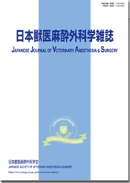Currently, there has been an increased risk of ureterolithiasis in cats; most of these stones are calcium oxalate ones, and responsible for ureteral obstruction. Feline ureteral obstruction may occur due to either the stone itself or may be secondary to ureteral fibrosis or granuloma formation. Due to the absence of stones in some cases, a workup for suspected ureteral obstruction is recommended if ultrasonography shows dilatation of the renal pelvis or ureter. While obstruction of a single ureter is less likely to cause serious injury, stricture of both ureters requires urgent treatment. In cases of calcium oxalate stones, surgery is often indicated. Once acute renal injury sets in, even with the resolution of ureteral obstruction, fibrosis of renal tubular interstitium is likely to advance, further progressing to chronic renal disease. This article focuses on the causes, pathological changes, clinical manifestations, diagnostic modalities, treatment modalities, and prognostic management of feline ureterolithiasis.
View full abstract
